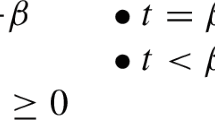Abstract
Generalizations of partial meet contraction are introduced that start out from the observation that only some of the logically closed subsets of the original belief set are at all viable as contraction outcomes. Belief contraction should proceed by selection among these viable options. Several contraction operators that are based on such selection mechanisms are introduced and then axiomatically characterized. These constructions are more general than the belief base approach. It is shown that partial meet contraction is exactly characterized by adding to one of these constructions the condition that all logically closed subsets of the belief set can be obtained as the outcome of a single (multiple) contraction. Examples are provided showing the counter-intuitive consequences of that condition, thus confirming the credibility of the proposed generalization of the AGM framework.
Similar content being viewed by others
References
Alchourrón C., Gärdenfors P., Makinson D. (1985) On the logic of theory change: Partial meet contraction and revision functions. Journal of Symbolic Logic 50: 510–530
Alchourrón C., Makinson D. (1981) Hierarchies of regulations and their logic. In: Hilpinen R. (eds) New studies in deontic logic: Norms, sctions, and the foundations of ethics. D. Reidel Publishing, Dordrecht, pp 125–148
Alchourrón C., Makinson D. (1982) On the logic of theory change: Contraction functions and their associated revision functions. Theoria 48: 14–37
Fishburn P. C. (1970) Intransitive indifference with unequal indifference intervals. Journal of Mathematical Psychology 7: 144–149
Fishburn P. C. (1970) Intransitive indifference in preference theory: A survey. Operations Research 8: 207–228
Fuhrmann A., Hansson S. O. (1994) A survey of multiple contractions. Journal of Logic, Language, and Information 3: 39–76
Grove A. (1988) Two modellings for theory change. Journal of Philosophical Logic 17: 157–170
Hansson S. O. (1991) Belief contraction without recovery. Studia Logica 50: 251–260
Hansson S. O. (1993) Theory contraction and base contraction unified. Journal of Symbolic Logic 58: 602–625
Hansson S. O. (1993) Changes of disjunctively closed bases. Journal of Logic, Language, and Information 2: 255–284
Hansson S. O. (1999) A textbook of belief dynamics theory change and database updating. Kluwer Academic Publishers, Boston
Hansson S. O. (2008) Specified meet contraction. Erkenntnis 69: 31–54
Hansson, S. O. (2012a). An axiomatic characterization of base-generated multiple partial meet contraction. Studies in Logic (in press).
Hansson, S. O. (2012b). Outcome level analysis of belief contraction. Submitted.
Hansson, S. O. (2012c). Repertoire contraction. Submitted.
Luce R. D. (1956) Semiorders and a theory of utility discrimination. Econometrica 24: 178–191
Manders K. L. (1981) On JND representation of semiorders. Journal of Mathematical Psychology 24: 224–248
Roberts, F. S. (1979). Measurement theory, Vol. 7. In Gian-Carlo R. (Ed.), Encyclopedia of mathematics and its applications. Reading, MA: Addison-Wesley.
Scott D., Suppes P. (1958) Foundational aspects of theories of measurement. Journal of Symbolic Logic 23: 113–128
Suppes P., Zinnes J. L. (1963) Basic measurement theory. In: Luce R. D., Bush R. R., Galanter E. (eds) Handbook of mathematical psychology, Vol. I. Wiley, New York, pp 1–76
Author information
Authors and Affiliations
Corresponding author
Rights and permissions
About this article
Cite this article
Hansson, S.O. Maximal and perimaximal contraction. Synthese 190, 3325–3348 (2013). https://doi.org/10.1007/s11229-012-0167-y
Received:
Accepted:
Published:
Issue Date:
DOI: https://doi.org/10.1007/s11229-012-0167-y




